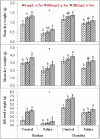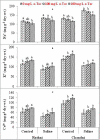Physiological, Biochemical, and Yield Responses of Linseed (Linum usitatissimum L.) in α-Tocopherol-Mediated Alleviation of Salinity Stress
- PMID: 35720587
- PMCID: PMC9204098
- DOI: 10.3389/fpls.2022.867172
Physiological, Biochemical, and Yield Responses of Linseed (Linum usitatissimum L.) in α-Tocopherol-Mediated Alleviation of Salinity Stress
Abstract
Exogenous application of antioxidants can be helpful for plants to resist salinity, which can be a potentially simple, economical, and culturally feasible approach, compared with introgression and genetic engineering. Foliar spraying of alpha-tocopherol (α-tocopherol) is an approach to improve plant growth under salinity stress. Alpha-tocopherol acts as an antioxidant preventing salinity-induced cellular oxidation. This study was designed to investigate the negative effects of salinity (0 and 120mM NaCl) on linseed (Linum usitatissimum L.) and their alleviation by foliar spraying of α-tocopherol (0, 100, and 200mg L-1). Seeds of varieties "Chandni and Roshni" were grown in sand-filled plastic pots, laid in a completely randomized design in a factorial arrangement, and each treatment was replicated three times. Salinity significantly affected linseed morphology and yield by reducing shoot and root dry weights, photosynthetic pigment (Chl. a, Chl. b, total Chl., and carotenoids) contents, mineral ion (Ca2+, K+) uptake, and 100-seed weight. Concomitantly, salinity increased Na+, proline, soluble protein, peroxidase, catalase, and superoxide dismutase activities in both varieties. Conversely, the growth and yield of linseed varieties were significantly restored by foliar spraying of α-tocopherol under saline conditions, improving shoot and root dry matter accumulation, photosynthetic pigment, mineral ion, proline, soluble protein contents, peroxidase, catalase, superoxide dismutase activities, and 100-seed weight. Moreover, foliar spray of α-tocopherol alleviated the effects of salinity stress by reducing the Na+ concentration and enhancing K+ and Ca2+ uptake. The Chandni variety performed better than the Roshni, for all growth and physiological parameters studied. Foliar spray of α-tocopherol (200mg L-1) alleviated salinity effects by improving the antioxidant potential of linseed varieties, which ultimately restored growth and yield. Therefore, the use of α-tocopherol may enhance the productivity of linseed and other crops under saline soils.
Keywords: enzymatic antioxidants; foliar application; linseed; saline; α-tocopherol.
Copyright © 2022 Abdullah, Mahmood, Bibi, Naqve, Javaid, Zia, Jabbar, Ud-Din, Attia, Khan, Al-Doss and Fiaz.
Conflict of interest statement
The authors declare that the research was conducted in the absence of any commercial or financial relationships that could be construed as a potential conflict of interest. The reviewer SF declared a shared affiliation with the author SF to the handling editor at the time of review.
Figures





Similar articles
-
Alpha Tocopherol-Induced Modulations in the Morphophysiological Attributes of Okra Under Saline Conditions.Front Plant Sci. 2021 Dec 21;12:800251. doi: 10.3389/fpls.2021.800251. eCollection 2021. Front Plant Sci. 2021. PMID: 34992625 Free PMC article.
-
Alleviating salinity stress in canola (Brassica napus L.) through exogenous application of salicylic acid.BMC Plant Biol. 2024 Jun 27;24(1):611. doi: 10.1186/s12870-024-05314-y. BMC Plant Biol. 2024. PMID: 38926637 Free PMC article.
-
Foliar Spray of Alpha-Tocopherol Modulates Antioxidant Potential of Okra Fruit under Salt Stress.Plants (Basel). 2021 Jul 6;10(7):1382. doi: 10.3390/plants10071382. Plants (Basel). 2021. PMID: 34371585 Free PMC article.
-
Exogenous application of salicylic acid ameliorates salinity stress in barley (Hordeum vulgare L.).BMC Plant Biol. 2024 Apr 11;24(1):270. doi: 10.1186/s12870-024-04968-y. BMC Plant Biol. 2024. PMID: 38605311 Free PMC article.
-
Foliar applied fullerol differentially improves salt tolerance in wheat through ion compartmentalization, osmotic adjustments and regulation of enzymatic antioxidants.Physiol Mol Biol Plants. 2020 Mar;26(3):475-487. doi: 10.1007/s12298-020-00761-x. Epub 2020 Jan 23. Physiol Mol Biol Plants. 2020. PMID: 32205924 Free PMC article.
Cited by
-
Foliar application of esculin and digitoxin improve the yield quality of salt-stressed flax by improving the antioxidant defense system.BMC Plant Biol. 2024 Oct 15;24(1):963. doi: 10.1186/s12870-024-05626-z. BMC Plant Biol. 2024. PMID: 39402439 Free PMC article.
-
Improving the genetic potential of okra (Abelmoschus esculentus L.) germplasm to tolerate salinity stress.Sci Rep. 2023 Dec 6;13(1):21504. doi: 10.1038/s41598-023-48370-4. Sci Rep. 2023. PMID: 38057336 Free PMC article.
-
Salt Tolerance of Sea Flax (Linum maritimum L.), a Rare Species with Conservation Interest in Eastern Spain.Plants (Basel). 2024 Jan 19;13(2):305. doi: 10.3390/plants13020305. Plants (Basel). 2024. PMID: 38276762 Free PMC article.
-
Optimizing Tomato (Lycopersicon esculentum) Yield Under Salt Stress: The Physiological and Biochemical Effects of Foliar Thiourea Application.Plants (Basel). 2024 Nov 26;13(23):3318. doi: 10.3390/plants13233318. Plants (Basel). 2024. PMID: 39683111 Free PMC article.
-
Moderate Salinity of Nutrient Solution Improved the Nutritional Quality and Flavor of Hydroponic Chinese Chives (Allium tuberosum Rottler).Foods. 2023 Jan 3;12(1):204. doi: 10.3390/foods12010204. Foods. 2023. PMID: 36613420 Free PMC article.
References
-
- Ahmed K. B. M., Singh S., Sadiq Y., Khan M. M. A., Uddin M., Naeem M. (2021). Photosynthetic and cellular responses in plants under saline conditions. Front. Plant Soil Interact. 2021, 293–365. 10.1016/B978-0-323-90943-3.00007-9 - DOI
LinkOut - more resources
Full Text Sources
Miscellaneous

